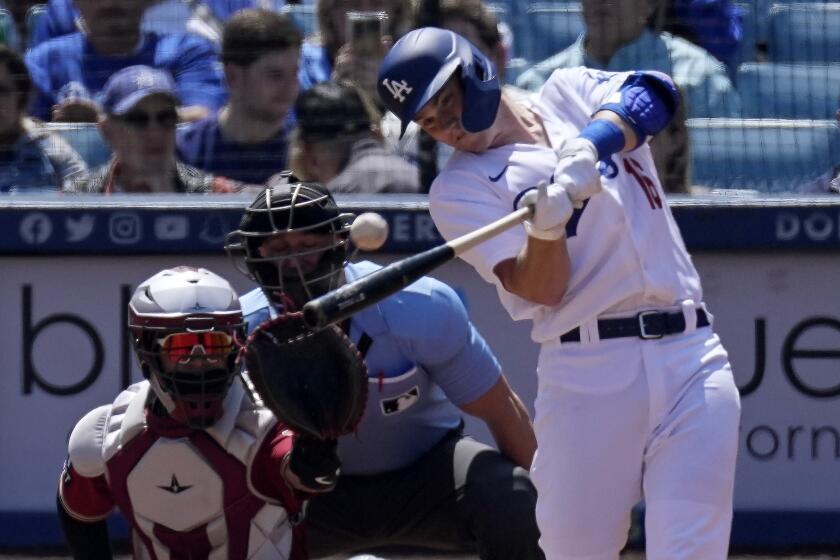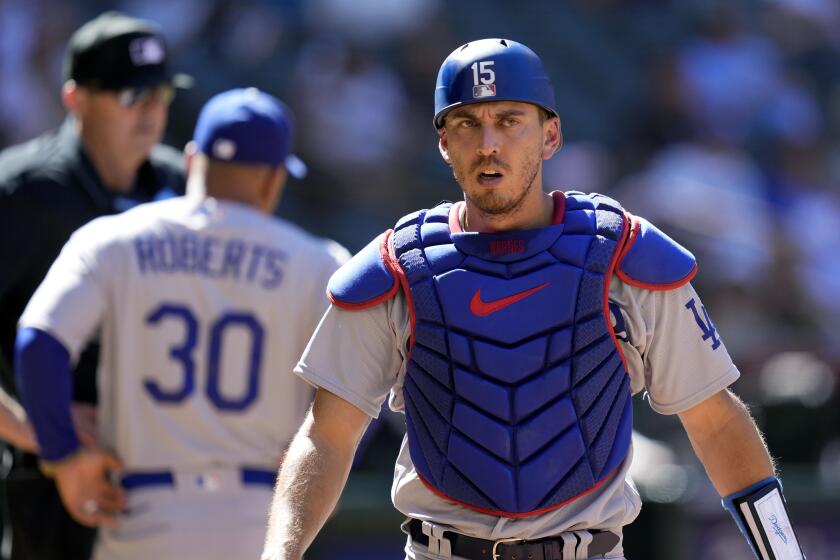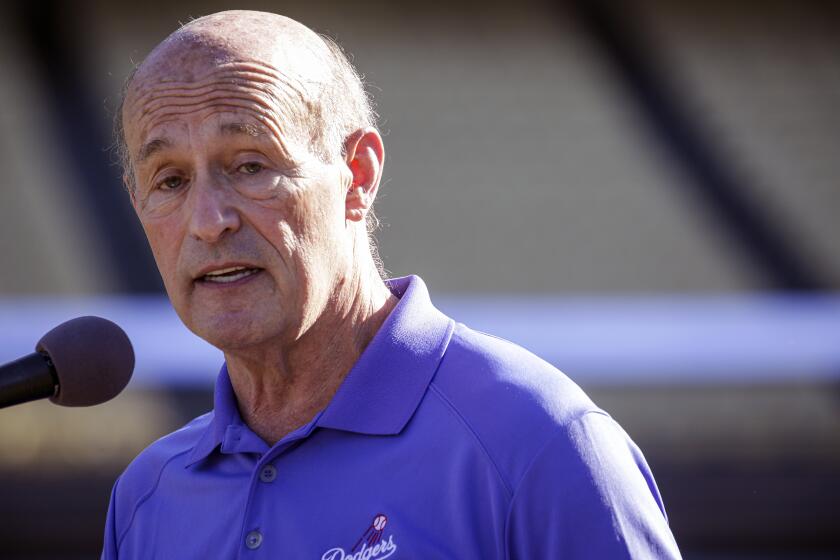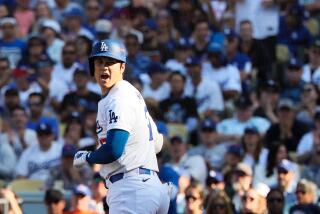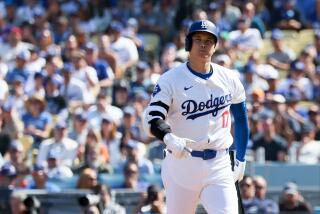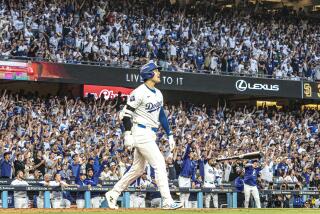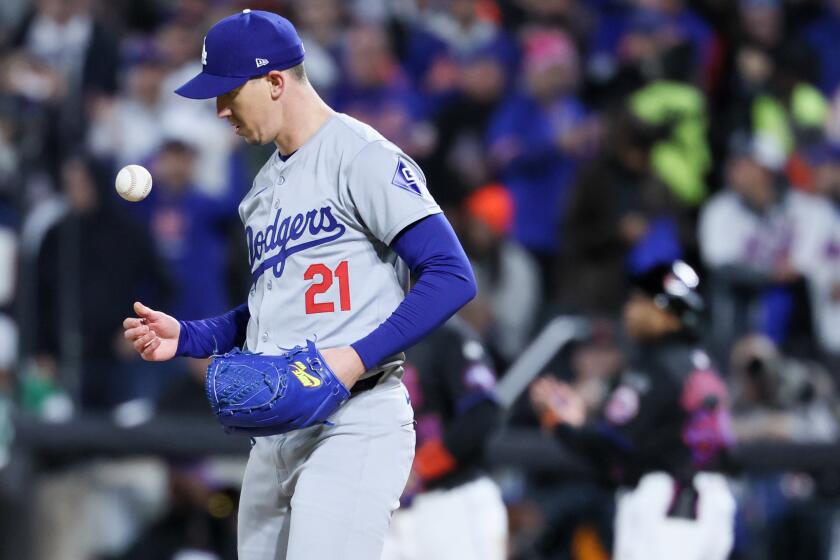
It wasn’t the most momentous development of James Outman’s young career, but Dave Roberts still felt the news was a pretty big deal.
A few nights before the start of the Dodgers’ season last week, and just days removed from making the club’s big league roster out of spring training, Outman was approached by his manager with another surprise honor for opening day.
Outman, Roberts said, would be the team’s starting center fielder for the first game of the year.
And while the 25-year-old rookie was grateful for the opportunity, he offered little other visual reaction.
“He sort of straight-faced me,” Roberts later said with a laugh. “He kind of gave me a nod while chewing his bubble gum, and that was it. It was good. I liked that.”
Will Smith is off to a fantastic start for the Dodgers. While the catcher might come across as boring, his skill and loyalty have him on a path to stardom.
Indeed, if Outman is feeling a whirlwind in his first extended MLB stint, he hasn’t shown it during a blistering first week and a half.
He validated his opening-day nod with a two-run homer in his Dodger Stadium debut. He tripled twice in a three-RBI outburst four days later. He took one of his childhood idols, Madison Bumgarner, deep on Friday, then hammered another long ball in the Dodgers’ loss Saturday.
And, when coupled with his four-game debut last year, he has orchestrated one of the hottest starts by a Dodgers rookie, ranking third in franchise history (behind Yasiel Puig and Cody Bellinger) with 32 total bases in his first 12 career games.
“I don’t think any moment is gonna be too big for him,” Roberts said, with Outman carrying a .348 batting average, .516 on-base-percentage and nine RBIs into Sunday’s action. “There’s just certain guys that special things are bound to happen.”
At every step of his burgeoning career — going from a raw college prospect to an unheralded mid-round draft pick to an undeniable rising star in the Dodgers’ crowded farm system — Outman has left a similar impression; praised for his quiet confidence and single-minded determination almost as much as the total transformation he has made to his game.
His coach at Sacramento State, Reggie Christiansen, saw it quickly during Outman’s freshman year, as the former high school catcher got a crash course playing the outfield for the first time in his life.
“The first couple months we put him out there, it wasn’t pretty,” Christiansen recalled. “But he’s such a good athlete, he’s such a good worker. He just always had so much belief in himself … that when he puts his mind to something, he’s gonna find a way to do it.”
Tom Kunis, the Dodgers’ Northern California area scout, quickly noticed it during an interview with Outman leading up to the 2018 draft.
“He was sitting there, literally locked in eye on eye,” Kunis said. “It was almost uncomfortable. Like, this guy is really paying attention. This guy is locked in. This guy cares about what I’m saying.”
And after the Dodgers selected Outman in the seventh round — taking a chance on the physically gifted but mechanically flawed project that the team knew was in need of a major swing change — club hitting consultant Craig Wallenbrock made his own observation of the young slugger’s unwavering mindset.
“The more I got to know him, the more I realized what it was,” Wallenbrock said, identifying one of the central themes to Outman’s emergence as a rookie sensation. “It was that football mentality that he has.”
In Outman’s rise to the major leagues, football was indeed intertwined at almost every important step.
A two-sport athlete at powerhouse Junípero Serra High in San Mateo, Outman originally felt most at home on the gridiron.
His 6-foot-3 frame made him a natural fit at inside linebacker, where his varsity coach, Patrick Walsh, remembered Outman spending “the majority of his career engaged in the other team’s backfield.”
It’s what forged his renowned tenacity as well.
“He was tough, scrappy, instinctive, physical,” Walsh said. “He’s more on the quiet side. But man, he was a vicious [middle] linebacker.”
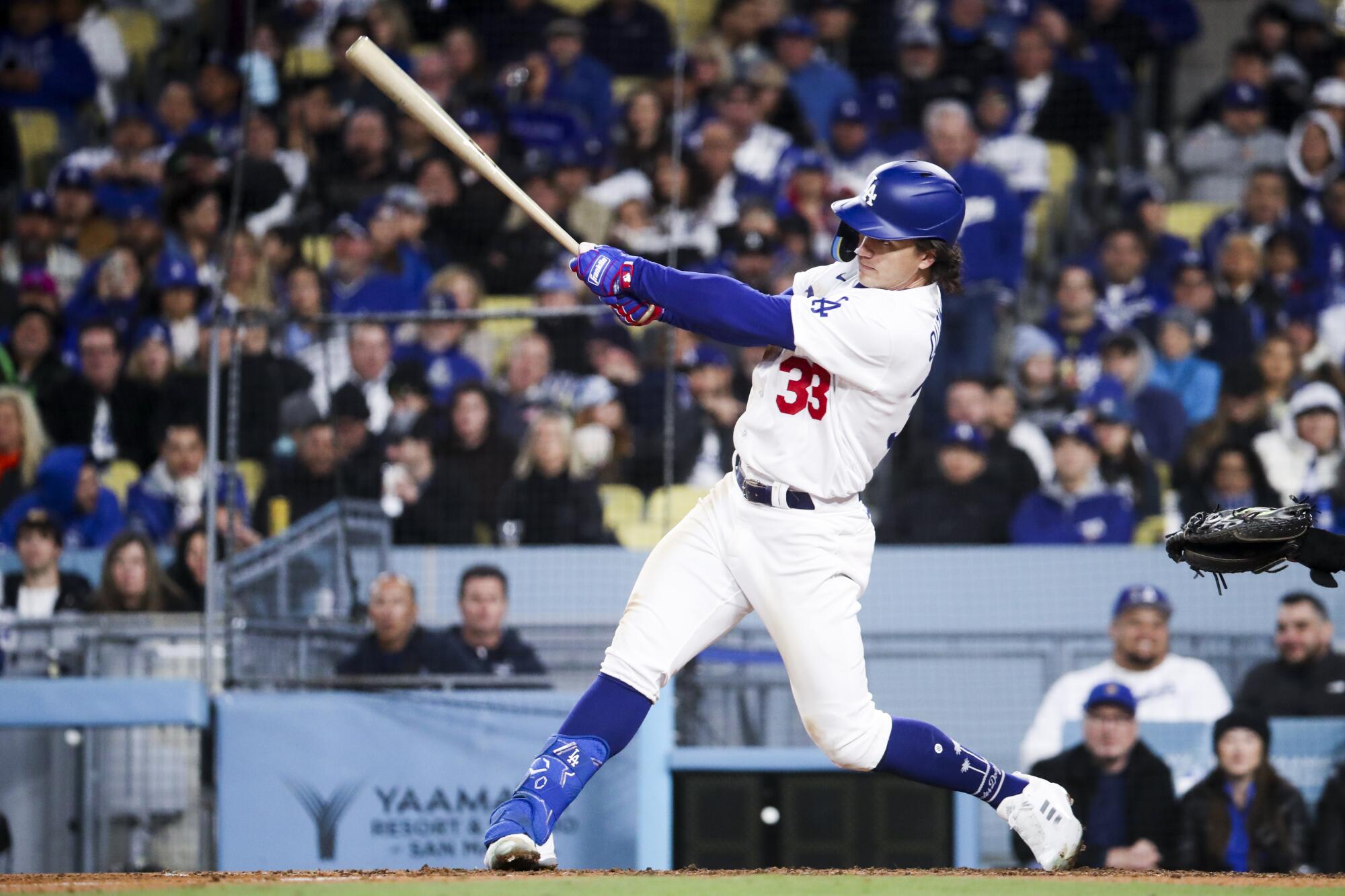
Those traits stayed with Outman as he shifted his focus to baseball in college, bypassing football opportunities at the Football Championship Subdivision level to pursue a career on the diamond instead.
“I liked practicing baseball way more,” he said. “I loved the games in football, but practice in football is tough.”
Mentally, his dual-sport upbringing fostered an intensity few of his baseball peers could match.
“It’s a pretty rare breed in a baseball player,” Christiansen, his college coach, said. “[He was] tough and determined like that, but also really smart.”
Physically, though, years of taking hits and making tackles made his body rigid and stiff, leaving his more fluid athleticism largely untapped.
“His body was so tight from football,” Wallenbrock said. “So it was more a question of getting in the training room and loosening up.”
Poor pitching explains only part of the reason why the Dodgers lost three of four games to the Arizona Diamondbacks. Is it a fluke or something bigger?
That’s why, when the Dodgers drafted Outman in 2018, they asked if he’d be willing to work with their player development staff right away. They had a long to-do list to turn Outman’s “Caveman”-like swing, as he jokingly referred to it, into a more graceful, dynamic motion.
And just as Kunis had predicted following his in-person meeting with the team’s newest prospect, Outman was ready to immediately buy in.
“I was like, hell yeah,” Outman said. “You know it’s gonna be a big project. But you’re excited for it. Because you know the outcome is gonna be in your favor.”
Outman embarked on the “total swing rebuild” with a piecemeal approach, perfecting one new aspect of his mechanics before moving to the next.
He added a front leg kick to hone his timing and flattened what had been a strikeout-prone bat path — common staples of many Dodgers swing-change plans.
He also trained his front side to remain more stable and closed off. And he even embraced some unusual tactics from former minor league hitting instructor Keith Beauregard (now the hitting coach of the Detroit Tigers) to improve his coordination with his weaker left hand — a crucial component of his left-handed swing.
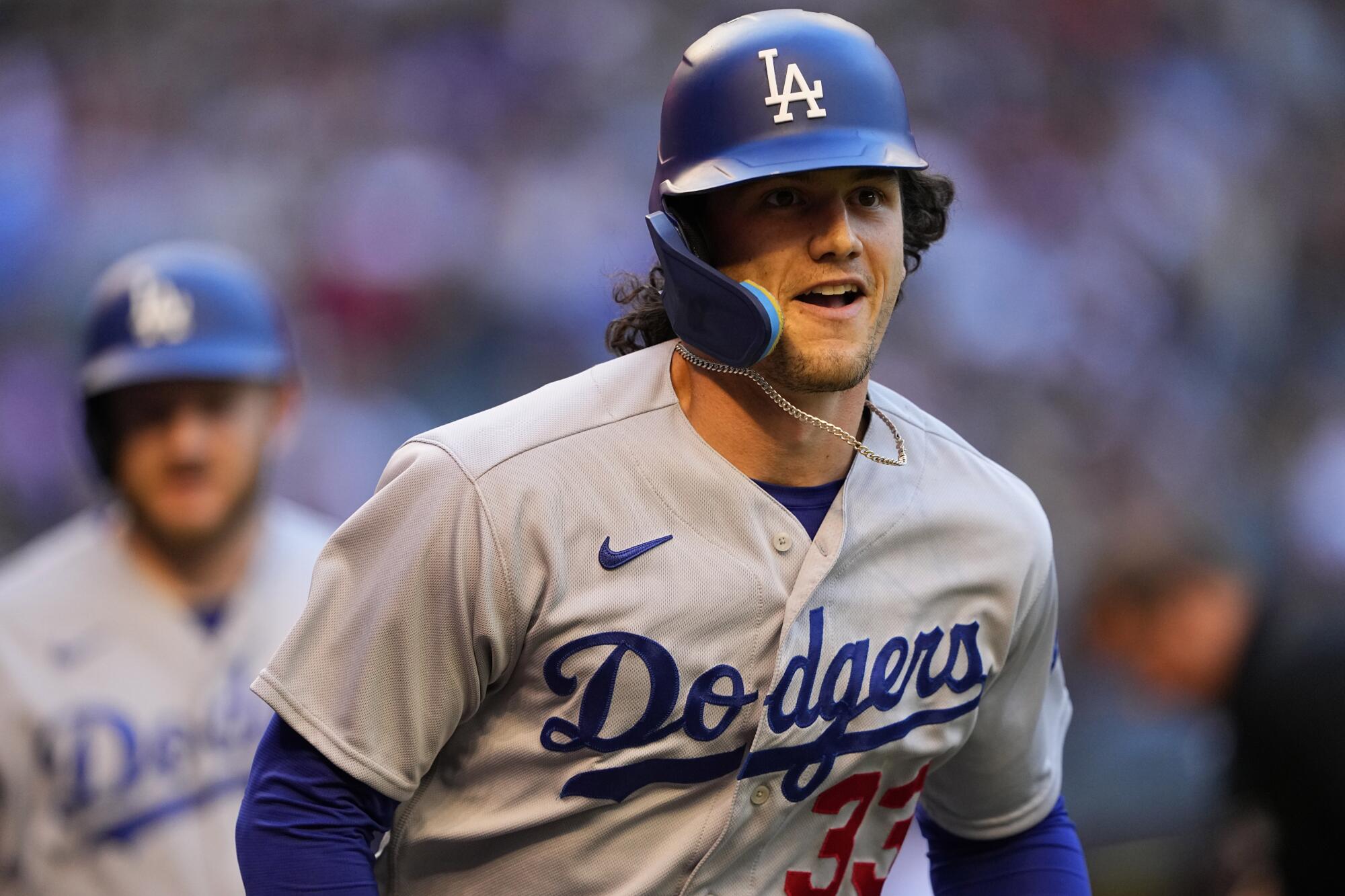
“Keith was saying, you got to learn to develop special skills with your left hand,” Wallenbrock said. “So he bought him a bunch of coloring books and crayons, and told him to start coloring in between the lines, keep it fine tuned.”
“It was kind of a joke,” Wallenbrock added with a laugh. “But you know what, he was the perfect guy to do it and laugh about it and kid about the fact that, even this was going to make him better.”
The work was tedious. And improvement wasn’t rapid.
Outman hit 30 home runs in his first two minor league seasons, but also batted just .238 while striking out in almost a quarter of his at-bats.
Still, his confidence didn’t wane. His football-bred fortitude never relaxed.
“The way he looked right through you, you’re not gonna be able to bull— this guy,” Wallenbrock said. “He was intent. And … because of that, it made it easier for him to make changes. It made him more driven to even try more.”
The biggest turning point in Outman’s path came amid the most unexpected of circumstances, when he was stuck at home in the Bay Area following the pandemic-prompted cancellation of the 2020 minor-league season.
Without an affiliate to play for, or an invitation to the Dodgers’ alternate site camp, Outman looked for alternative ways to continue his development.
It was Kunis who devised a work-around answer.
A longtime college pitching coach before he became a scout, Kunis managed to organize twice-weekly workouts for local Dodgers prospects at Sacramento State’s facility during the summer lockdown.
And for Outman, one of the few hitters able to make the drive to the pitcher-heavy camp, it offered the chance for virtually unlimited live at-bats.
“He had the foundation in place,” Kunis said. “But he could work on those little things, without having the consequences of a game. There was a freedom to make adjustments, and try this or that.”
Outman, essentially, became his own swing coach.
Every day, he discussed his plate appearances with the camp’s other pitchers, including fellow future big leaguer Justin Bruihl. On his two-hour commute home, Outman would mentally review his swing progress and ponder potential tweaks.
“I kind of got to feel things out for myself,” he said. “Think about my swing on my own.”
When relaxed pandemic restrictions allowed Dodgers coaches to finally work with Outman in person again near the end of that year, they immediately noticed the changes.

“It was all to his credit,” hitting coach Aaron Bates said. “His swing when he came back, it was awesome.”
Four years later, he had achieved the swing they envisioned when they drafted him.
“That’s how it’s supposed to be,” Bates added. “That’s what it was when I was playing and growing up. You get your program, then you go off for a winter and get better and come back and get a chance to make a first impression all over again. It lets me know guys are working, that they are high-character guys. “
Before long, Outman’s stock was on the rise.
He dominated in instructional camp in the fall of 2020, then caught Roberts’ eye with his play the following spring. He reached double A for the first time in 2021, where he batted .289.
Last year, he excelled both in triple A, posting a 1.018 on-base-plus-slugging percentage, and during his brief MLB debut, an impressive four-game stint with a home run in his first career at-bat.
“You see the changes happen,” Outman said, “and I was like, ‘Wow. All that stuff wasn’t for no reason.’ ”
He doesn’t do it often, but Outman never ceases to be amazed when he looks back at film of his old stiff swing.
“Sometimes, I’ll be joking around with guys, like, ‘You should have seen my swing when I came here,’ ” he said. “Then we’ll pull up the video. And it’s like, ‘Yeah, that was pretty different.’ ”
Looking back, though, he makes the process sound surprisingly simple, as if there was some Ikea-esque instruction manual to fine-tuning all the disparate pieces.
“A lot of it was, ‘I’m gonna work on this, and I’m gonna keep doing it until I feel like I’ve made it second nature,’ ” he said. “You go one step at a time the whole way.”
To Wallenbrock, it all was a reflection of Outman’s football background. Because his athletic career wasn’t built on a baseball-only foundation, he wasn’t conditioned to flatly accept the failure the sport inevitably brings.
“That football mentality is, you’re building for a must-win every weekend,” Wallenbrock said. “That’s the mentality I recognized in James right away. … He likes the grind. He enjoys the grind. So it’s not a grind for him.”
Not nearly as much as during his days toiling with coloring books and simulated at-bats, at least.
Already, the slugger is playing his way into an important role on the Dodgers’ new-look team. He has provided an enticing option against right-handed pitching. He’s capable of playing plus defense at any of the three outfield positions. And he’s fulfilling the hopes many around the organization had long expected.
Dodgers CEO Stan Kasten backs Andrew Friedman and Dave Roberts but says of the roster: ‘We are now on the precipice of the next wave of young guys.’
“Everybody deserves a high five,” Kunis said of Outman’s rise through the farm system. “It’s just a well-done process. We kind of knew what we thought we were gonna get. And no one is surprised [to see him do this].”
Outman acknowledged there is still room to grow, that he is probably “always gonna be tinkering” with his swing.
“But,” he added, “I feel like the major changes are out of the way. I’ve learned how I move. I learned my swing a little bit more. It’s a lot more fine-tuning now than it is major fixes.”
As he walked out of the clubhouse Monday night, Outman even let down his stoic demeanor for a brief moment, looking up from his phone with a satisfied smile when asked if he knew he’d become the first Dodger with two triples in a game since Puig in 2014.
“Yeah,” he said, glancing at a social media feed buzzing with excitement over his latest big league feat. “Twitter told me.”
More to Read
Are you a true-blue fan?
Get our Dodgers Dugout newsletter for insights, news and much more.
You may occasionally receive promotional content from the Los Angeles Times.

